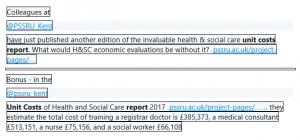October 28, 2019
 By Amanda Burns – Research Assistant
By Amanda Burns – Research Assistant
Every December PSSRU publish a new Unit Costs of Health & Social Care volume and we are always pleased with the positive reception and usage the report receives. More recently we have been undertaking a number of exercises to try to explore in more detail how the Unit Costs of Health & Social Care volume is used and by whom.
To begin with we carried out a standard literature search on Web of Knowledge to identify how we were feeding in to economic evaluations of health and social care in the UK. We were able to identify that the report was cited in approximately 66% of all UK economic evaluations which is a very substantial share. This helps to ensure these economic evaluations are using high quality and consistent unit costs, enabling them to draw more accurate conclusions. Papers citing our report appeared in a number of highly valued journals such as BMJ and covered a wide range of health and social care topics.
Some examples of these are:
- Leal et al (2014) Cost-effectiveness of a pragmatic structured education intervention for the prevention of type 2 diabetes: economic evaluation of data from the Let’s Prevent Diabetes cluster-randomised controlled trial, BMJ Open
- Shearer et al (2016) Economic evalution of mental health interventions, a guide to costing approaches, PharmaEconomics
- Smith et al (2017) Clinical and economic evaluation of a case management service for patients with back pain, Journal of Evaluation in Clinical Practice
Social media, in particular Twitter, can also be useful in showing us where our work feeds in to that of some high profile researchers:
In addition to simply how much the report is being used we are also keen to identify how it is used. This year we were delighted to be able to liaise directly with a local authority who discussed the use of the report at one of their regular meetings and fed back to us on how it was used and what value this created. We were able to identify that our contacts used the report for benchmarking nationally and to add meaning to their data. We were also able to identify the individuals within the authority who found it most useful, enabling us to target our mail outs more effectively.
Our report is also used by a number of voluntary sector organisations to assist with their costing processes. We were able to provide supporting evidence to a Kent charity in their efforts to challenge a charge made upon them by HMRC and have also worked with a children’s charity to feed in to a Green Paper on Transforming children and young people’s mental health provision.
Of course, along with many others we face the problem of how to ensure we are correctly referenced. We are sure we miss out on a large number of citation records due to the report being cited simply as Unit Costs, or Unit Costs of Health & Social Care, rather than by the authors.
We know NICE use the report in their economic appraisals (including via the aforementioned economic evaluation studies that inform those appraisals) and we are mentioned as a resource in NICE guidelines “Information on unit costs should be routinely obtained from national list prices such as the NHS drug tariff, the PSSRU (Personal Social Services Research Unit) Unit costs of health and social care or Department of Health reference costs”, NICE (2012), https://www.nice.org.uk/process/pmg6/chapter/assessing-cost-effectiveness.
However, for the most part we have difficulty identifying how our report is used to inform policy since many of these documents come under the heading of “grey literature”.
From our contacts in the Department of Health and Social Care and the Department for Education we know it is used to support central government policy documents, Impact Assessments and white papers but have been unable to identify a suitable method to identify the vast majority of these. This is an important area for us and would be interested to hear from any of our readers who have ideas for addressing this problem.
For now though we are hopeful that the popularity and usage of the Unit Costs volume will continue to grow and grow.
This study/project is funded by the National Institute for Health Research (NIHR) [Policy Research Programme, Unit Costs of Health and Social Care, 035/0093.]. The views expressed are those of the authors and not necessarily those of the NIHR or the Department of Health and Social Care.


